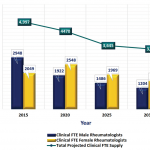
Who will take care of my patients when I retire? As a clinician with an established rheumatology practice, I’ve found myself asking this question more frequently in recent years, and academic rheumatologists are the key to answering it. To solve some workforce issues—like who will take over my practice—we need a larger supply of training programs, quality trainees to enter the programs, and academic rheumatologists prepared to teach.
The Rheumatology Workforce
The ACR’s 2006 Rheumatology Workforce Study, which was completed by The Lewin Group, found that the median age of adult rheumatologists in 2005 was 51. These doctors are in their most productive working years now, but are set to retire within the next 15 to 20 years. Although 94% of these physicians currently treat patients, the size of the overall patient population has grown dramatically in recent years. In many areas, rheumatologists are already having difficulty keeping up with demand for their services. Demand promises to increase even more as the large baby-boomer generation ages and requires more rheumatology care. While the demand for rheumatologists’ services is projected to increase by 46% over the next 20 years, the number of practicing adult rheumatologists is projected to remain relatively flat, increasing by only 1.2% during the same period. Pediatric rheumatology doesn’t face quite as steep a challenge in the coming years because a parallel surge in the patient population is not expected, but the trend toward excess demand is still there.
Training Future Clinicians
One way to mitigate this excess demand is to expand the number of rheumatology training programs and fellowship positions, which would increase the supply of rheumatologists. Some progress is being made in this area. Over the past five years, an average of 150 rheumatology fellows have completed adult training programs each year, compared with an average of 115 fellows completing these programs each year over the previous five-year period.
But to attract and train new clinicians and researchers, training programs require skilled academic rheumatologists who are committed to rheumatology training, patient care, and research. Without this faculty, the recent growth in rheumatology training programs cannot be maintained. In a February 2007 report on the state of the rheumatology training environment, the ACR Committee on Training and Workforce Issues noted: “Academic rheumatology programs must successfully engage in a variety of inter-related but distinct activities to provide a quality, stable, and accredited fellowship program. These activities include clinical care, education, and research. The success of each of these activities is first and foremost dependent upon the presence of qualified academic rheumatology faculty.”
Research and Funding
Currently there are between 700 and 800 academic rheumatologists in the United States.1 Academicians are generally required to conduct research and compete successfully for outside grant funding to cover at least part of their salaries. The balance must usually be covered by reaching relative value unit targets in the clinical setting, a challenge when balanced with a myriad of research, teaching, and administrative responsibilities. According to the Lewin study, 73% of academic rheumatologists are required to cover more than half of their salaries through grants, yet many are finding it increasingly difficult to do so. In recent years, funding from the National Institutes of Health has declined substantially. The ACR Research and Education Foundation (REF) and other organizations have strengthened their own grant programs to help fill this gap. The REF “Within Our Reach” program—a major funding source for RA research—is one such example.
Sixty-six percent of academic rheumatologists in the Lewin study reported that it took five to 10 years to achieve independent investigator status. Further, more than 80% of rheumatologists who left academics within the last five years said they did so because of “lack of support” or “difficulty funding research.” They were also attracted to non-academic careers by higher pay—the median compensation for private practitioners rose by 28.1% between 1998 and 2002, whereas compensation for academic faculty rose only 11.3% during the same period.1
When the Young Investigator Subcommittee of the ACR Committee on Research polled fellows about their career choices in 2006, they ranked salary among their chief concerns. It appeared from this survey that baseline interest in academia was strong but fellows were concerned about both salary and funding difficulties. The supply of new academic rheumatologists will almost certainly become limited if these financial issues are not addressed.
Funding issues must be tackled at both the local and federal levels. Institutions do not always recognize the value of rheumatology divisions or the downstream revenue they generate. As rheumatologists, we must correct these misperceptions when they arise. In addition, we should continue to advocate at a federal level for increased research funding and reimbursement for our services, both of which will contribute to the health of our academic divisions and therefore to the strength of the subspecialty.
In recent years, the ACR has met annually with Stephen Katz, MD, PhD, director of the National Institute of Arthritis and Musculoskeletal and Skin Diseases, to advocate for increased rheumatology grant funding. These interactions complement existing congressional advocacy efforts by ACR members on proposed legislation that would affect research funding or medical education support. Rheumatologists in clinical practice think mainly about advocacy related to access to care and reimbursement issues, but lobbying efforts for research snd training are equally important. In fact, in 2005 the ACR developed a rheumatology research agenda to guide our advocacy efforts in this area.
Make a Difference in Rheumatology’s Future
The best way for you to positively affect the specialty’s future is one relationship at a time. According to an unpublished 2006 ACR survey of U.S. adult and pediatric fellows, early exposure to rheumatology can strengthen interest in the field.2 Nearly half of respondents stated that they first became interested in rheumatology in medical school. By far the most important factors that influenced fellows to choose rheumatology were a clinical mentor and a clinical rotation. Rheumatologists in academia have obvious opportunities to mentor trainees, but there are also opportunities for practitioners who are willing to mentor. The ACR organizes online mentoring networks and annual meeting informal mentoring sessions. Practitioners are always in high demand and short supply for these sessions. In addition, the REF offers preceptorships that require research and clinical mentors.
If we are worried about who will care for our patients when we retire, we should be equally concerned with the current challenges facing rheumatology training programs and those who run them. These programs will nurture the next generation of practitioners, researchers, and teachers who will support our patients at the bedside and develop new therapies that will improve patients’ quality of life.
If our patients are to benefit from future therapies and research advances, we must be concerned about the research funding available to develop those therapies. We must advocate for adequate research funding as well as access to care and new therapies that improve patient outcomes.
Academic rheumatology issues are not only the concern of the academic rheumatologists in our midst. It is every rheumatologist’s responsibility to ensure continued growth of the subspecialty and, as a result, the future care of their patients.
Dr. Birnbaum is president of ACR. Contact him via e-mail at [email protected].



